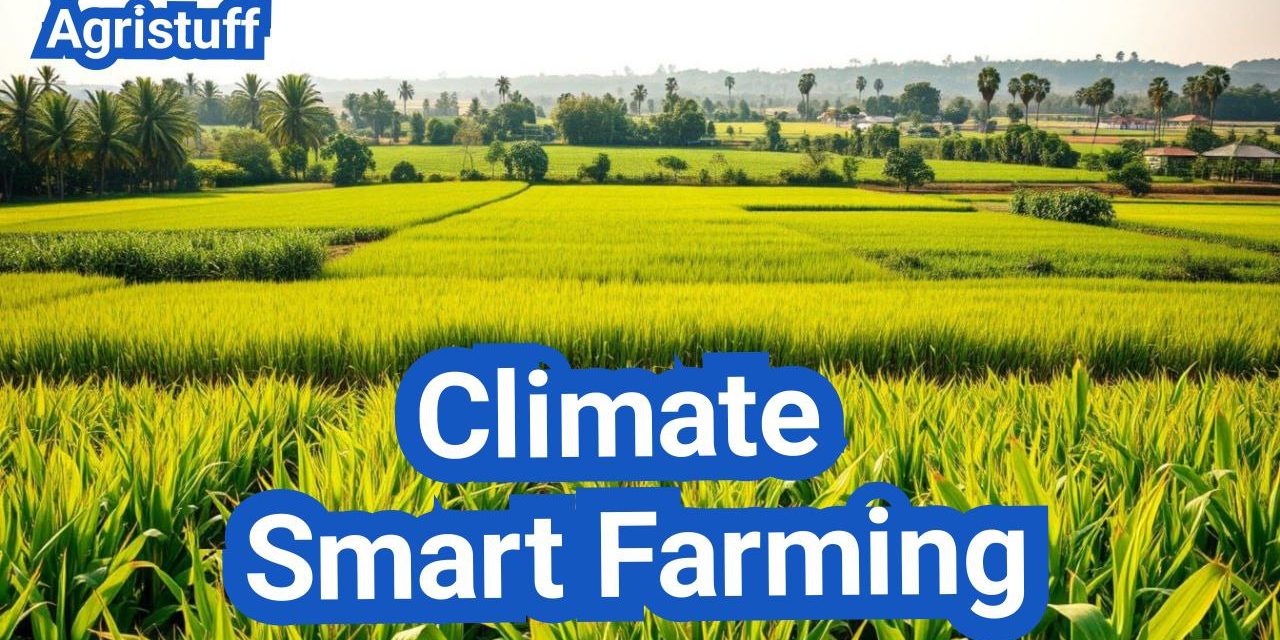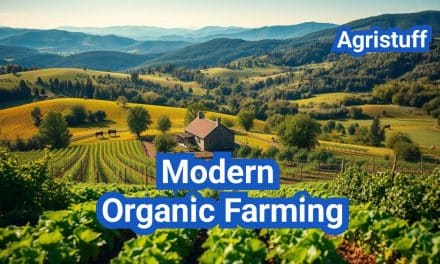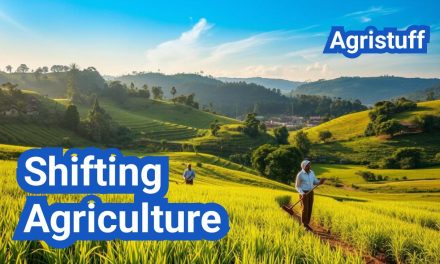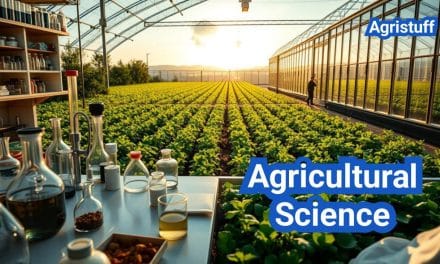As the world grapples with the challenges of climate change, climate-smart agriculture has emerged as a vital strategy for ensuring a sustainable future. This approach not only helps protect the environment but also empowers smallholder farmers in India with new economic opportunities.
By adopting sustainable farming practices, farmers can improve their productivity and contribute to a more food-secure world. Eco-friendly farming methods and climate-resilient crops are key components of this approach, enabling farmers to adapt to the changing climate while maintaining the health of their land.
Key Takeaways
- Climate-smart agriculture is crucial for a sustainable future.
- Sustainable agriculture practices improve productivity and food security.
- Eco-friendly farming methods help farmers adapt to climate change.
- Climate-resilient crops are essential for maintaining land health.
- Adopting climate-smart agriculture empowers smallholder farmers economically.
The Climate Crisis and Agriculture: Understanding the Connection
The climate crisis is deeply intertwined with agriculture, affecting farmers and the global food supply. As extreme weather events such as droughts, flooding, and major storms become more frequent and intense due to climate change, the agricultural sector faces significant challenges.
These climate-related events have led to widespread yield losses and increasing threats to food security. Understanding the connection between the climate crisis and agriculture is crucial for developing effective strategies to mitigate these impacts.
Current Climate Challenges Facing American Farmers
American farmers are experiencing a range of climate-related challenges. Rising temperatures, changing precipitation patterns, and increased frequency of extreme weather events are affecting crop yields and farm productivity.
Key climate-related challenges include:
- Increased frequency and severity of droughts and heatwaves
- More intense and frequent flooding
- Shifts in seasonal weather patterns affecting planting and harvesting schedules
The Agricultural Sector’s Contribution to Climate Change
Agriculture is not only affected by climate change but also contributes to it. The sector is a significant source of greenhouse gas emissions, primarily due to practices such as livestock production, fertilizer use, and land-use changes.
| Source | Greenhouse Gas Emissions |
|---|---|
| Livestock Production | 14.5% of global GHG emissions |
| Fertilizer Use | 2.1% of global GHG emissions |
| Land-Use Changes (e.g., deforestation) | 15% of global GHG emissions |
The Urgent Need for Agricultural Adaptation
Given the interconnectedness of climate change and agriculture, adapting farming practices to the changing climate is imperative. Climate-smart agriculture offers a pathway to enhance agricultural productivity, resilience, and sustainability.
By adopting climate-resilient practices, farmers can reduce the risks associated with climate change, improve their livelihoods, and contribute to global food security.
What Is Climate-Smart Agriculture?

Climate-smart agriculture represents a paradigm shift in farming practices, focusing on sustainable productivity, resilience, and mitigation of climate change impacts. This approach integrates the social, economic, and environmental dimensions of agriculture to achieve a “triple win” for farmers, communities, and the environment.
Core Principles and Objectives
The core principles of climate-smart agriculture revolve around three main objectives:
- Sustainable productivity: Enhancing agricultural productivity and incomes while maintaining the natural resource base.
- Adaptation: Building resilience to climate change impacts, such as increased frequency of droughts and floods.
- Mitigation: Reducing greenhouse gas emissions from agricultural activities where possible.
The Triple Win: Productivity, Adaptation, and Mitigation
The “triple win” concept is central to climate-smart agriculture. It signifies the potential for agricultural practices to:
- Boost productivity through the use of climate-resilient crop and animal varieties, and improved farming practices.
- Enhance adaptation by building farmers’ resilience to climate-related shocks and stresses.
- Contribute to mitigation efforts by reducing the carbon footprint of agricultural activities.
Evolution of Climate-Smart Farming Practices
Climate-smart farming practices have evolved significantly over the years, incorporating a range of agroecology strategies and adaptive agriculture techniques. These include:
- Conservation agriculture
- Agroforestry
- Climate-smart crop management
- Efficient water management systems
By adopting these practices, farmers can improve their resilience to climate change, enhance their productivity, and contribute to a more sustainable agricultural sector.
Assessing Your Farm’s Climate Vulnerability
Evaluating the climate vulnerability of your farm is essential for identifying areas that require improvement. This process enables farmers to understand their farm’s exposure to climate-related risks and develop effective strategies for building resilience.
Conducting a Climate Risk Assessment
A climate risk assessment is a systematic process used to identify, analyze, and prioritize potential climate-related risks to your farm. This involves examining historical climate data, projected climate changes, and the potential impacts on your agricultural operation.
Key steps in conducting a climate risk assessment include:
- Collecting and analyzing historical climate data for your region
- Reviewing climate projections and models to understand potential future changes
- Identifying potential climate-related hazards such as droughts, floods, and heatwaves
- Assessing the vulnerability of your farm’s infrastructure, crops, and livestock to these hazards
Identifying Farm-Specific Climate Challenges
Every farm faces unique climate-related challenges based on factors such as location, soil type, and farming practices. Identifying these farm-specific challenges is crucial for developing targeted adaptation strategies.
Consider the following when identifying farm-specific climate challenges:
- Soil health and its impact on water retention and erosion risk
- Crop and livestock selection and their resilience to projected climate conditions
- Irrigation systems and water management practices
- Farm infrastructure, including buildings and equipment, and their vulnerability to extreme weather events
Creating a Baseline for Measuring Progress | Climate-Smart Agriculture
Establishing a baseline is essential for measuring the effectiveness of your climate adaptation strategies over time. This involves documenting current conditions, practices, and outcomes related to climate vulnerability.
Key elements to include in your baseline assessment:
- Current climate-related risks and vulnerabilities
- Existing adaptation measures and their effectiveness
- Baseline data on crop yields, water usage, and other relevant metrics
By following these steps, farmers can comprehensively assess their farm’s climate vulnerability and lay the groundwork for implementing effective agricultural adaptation strategies.
Soil Health Management for Climate Resilience

As climate change continues to pose significant challenges to agriculture, soil health management emerges as a critical strategy for resilience. Soil health is foundational to the success of climate-resilient agriculture, as it directly impacts the ability of soils to support plant growth, retain water, and sequester carbon.
Carbon Sequestration Through Improved Soil Practices
One of the key benefits of improved soil health is its potential for carbon sequestration. Practices such as cover cropping, reduced tillage, and the incorporation of organic amendments can significantly enhance the soil’s carbon storage capacity. This not only helps in mitigating climate change by reducing atmospheric CO2 levels but also improves soil fertility and structure.
By adopting these practices, farmers can contribute to climate change mitigation while also enhancing the productivity and resilience of their agricultural systems.
Reducing Tillage and Soil Disturbance | Climate-Smart Agriculture
Reducing tillage and minimizing soil disturbance are crucial for maintaining soil health. Intensive tillage can damage soil structure, disrupt soil biota, and lead to soil erosion. By reducing tillage, farmers can preserve soil organic matter, promote soil biota, and reduce the risk of soil erosion.
This approach also contributes to improved water retention and aeration in the soil, supporting healthier root growth and more resilient crops.
Building Organic Matter for Water Retention | Climate-Smart Agriculture
Building organic matter in the soil is another vital strategy for enhancing soil health and climate resilience. Organic matter improves the soil’s water-holding capacity, reducing the risk of drought stress and improving the overall water cycle. This can be achieved through the use of cover crops, manure application, and incorporating crop residues into the soil.
By enhancing water retention, farmers can reduce their reliance on irrigation, making their agricultural operations more sustainable and resilient to changing climate conditions.
Water Conservation and Management Techniques
As the agricultural sector faces increasing water scarcity, adopting conservation techniques becomes vital. Farmers are continually seeking innovative methods to manage water resources efficiently, ensuring the long-term sustainability of their operations.
Efficient Irrigation Systems and Technologies
One of the most effective ways to conserve water in agriculture is through the implementation of efficient irrigation systems. Technologies such as drip irrigation and precision sprinkler systems deliver water directly to the roots of plants, minimizing evaporation and runoff. These systems can be further optimized with the use of soil moisture sensors and weather data to adjust irrigation schedules according to actual crop needs.
The adoption of precision agriculture techniques also plays a crucial role in water conservation. By using data analytics and GPS technology, farmers can identify areas within their fields that require more or less water, allowing for targeted irrigation practices.
Rainwater Harvesting and Storage Solutions | Climate-Smart Agriculture
Rainwater harvesting is another valuable technique for conserving water. By collecting and storing rainwater, farmers can reduce their reliance on groundwater or municipal water supplies. This not only saves water but also decreases the energy required to pump and treat water.
Effective rainwater storage solutions include ponds, tanks, and reservoirs. These can be designed to capture and hold large quantities of rainwater during wet periods, making it available for irrigation during dry spells.
Drought-Proofing Your Agricultural Operation | Climate-Smart Agriculture
Drought-proofing involves implementing a range of strategies to ensure that your farm remains productive even during periods of water scarcity. This can include selecting drought-tolerant crop varieties, improving soil health through the addition of organic matter, and using mulches to reduce soil evaporation.
Additionally, developing a comprehensive water management plan that includes strategies for water conservation, efficient use, and storage can help farmers navigate drought conditions more effectively.
Implementing Climate-Smart Agriculture in Your Farm

Climate-smart agriculture is not just a concept; it’s a practical approach that farmers can implement to enhance their farm’s resilience. By adopting climate-smart practices, farmers can improve their agricultural productivity, adapt to climate change, and reduce greenhouse gas emissions.
Starting with High-Impact, Low-Cost Practices
Farmers can begin their climate-smart agriculture journey by implementing high-impact, low-cost practices. Some of these practices include:
- Conservation agriculture, which involves minimizing soil disturbance, maintaining soil cover, and rotating crops.
- Using drought-tolerant crop varieties and improving soil health through organic amendments.
- Adopting integrated pest management techniques to reduce chemical use.
These practices not only help in reducing the environmental footprint but also improve farm productivity and profitability.
Phased Implementation Approaches
A phased implementation approach allows farmers to gradually adopt climate-smart agriculture practices, starting with those that offer the most significant benefits or are easiest to implement. This approach helps in managing resources effectively and minimizing disruptions to farm operations.
Farmers can prioritize practices based on their farm’s specific needs and challenges. For instance, a farm facing frequent droughts might first implement drought-tolerant crop varieties and efficient irrigation systems.
Measuring and Verifying Results
To ensure the effectiveness of climate-smart agriculture practices, it’s crucial to measure and verify the results. This involves setting clear indicators for productivity, adaptation, and mitigation. Farmers can use various tools and methodologies to monitor their progress, including:
- Tracking changes in soil health, biodiversity, and water usage.
- Monitoring crop yields and resilience to climate-related stresses.
- Assessing reductions in greenhouse gas emissions.
By regularly assessing their progress, farmers can make informed decisions and adjust their strategies as needed to achieve their climate-smart agriculture goals.
Climate-Resilient Crop Selection and Management

The selection of climate-resilient crops is a critical strategy for farmers aiming to mitigate the impacts of climate change on their farms. By choosing crops that are adapted to the projected climate conditions, farmers can reduce the risk of crop failure and improve their overall resilience.
Drought and Heat-Tolerant Crop Varieties
One of the key strategies in climate-resilient crop management is the adoption of drought and heat-tolerant crop varieties. These crops are bred to withstand the stresses of higher temperatures and reduced water availability, making them ideal for regions increasingly affected by drought.
Examples of such crops include certain varieties of corn, soybeans, and wheat that have been genetically improved for drought tolerance. Additionally, crops like sorghum and millet are inherently more resilient to dry conditions and can serve as valuable alternatives in dry regions.
Diversification Strategies for Risk Management
Diversification is a fundamental principle in managing risk in agriculture. By growing a variety of crops, farmers can spread their risk and reduce their dependence on a single crop. This approach not only helps in managing climate-related risks but also improves soil health and biodiversity.
Diversification strategies can include planting multiple crop species, integrating crops with different growth cycles, and incorporating cover crops into the rotation. This diversified approach can enhance the overall resilience of the farming system.
Adjusting Planting Calendars for Changing Seasons
As climate change alters the timing and duration of seasons, farmers need to adjust their planting calendars accordingly. This involves understanding the new climate normals and planning planting dates based on the expected weather patterns.
Adjusting planting calendars can help farmers avoid extreme weather events, such as planting later in the spring to avoid late frosts or earlier in the fall to avoid early frosts. It also involves selecting crop varieties with appropriate maturity dates to match the changing growing seasons.
By implementing these climate-resilient crop selection and management strategies, farmers can enhance their ability to adapt to climate change, ensuring a more sustainable and productive agricultural operation.
Agroforestry Techniques for Climate Adaptation
Agroforestry techniques offer a promising approach to climate adaptation by integrating trees into agricultural landscapes. This practice not only enhances biodiversity but also improves the resilience of farming systems to climate change.
By adopting agroforestry, farmers can create more diverse and robust ecosystems that are better equipped to withstand the challenges posed by a changing climate.
Silvopasture: Integrating Trees and Livestock
Silvopasture is an agroforestry practice that involves integrating trees into pastures where livestock are raised. This approach can enhance the overall productivity of the farm by providing shade for animals, improving soil health, and increasing biodiversity.
The integration of trees and livestock in silvopasture systems can lead to improved carbon sequestration, as trees absorb carbon dioxide from the atmosphere and store it in their biomass and in the soil.
Windbreaks and Shelterbelts for Climate Protection
Windbreaks and shelterbelts are rows of trees or shrubs planted to protect crops and livestock from harsh winds. These barriers can reduce soil erosion, improve microclimates, and provide habitat for beneficial organisms.
By reducing the impact of wind on agricultural lands, windbreaks and shelterbelts can help farmers maintain productivity even during extreme weather events.
Alley Cropping and Multi-Story Cropping Systems
Alley cropping involves planting crops between rows of trees, creating a multi-story cropping system that maximizes land use efficiency. This practice can enhance biodiversity, improve soil health, and increase overall farm productivity.
Multi-story cropping systems mimic natural ecosystems, promoting ecological interactions between different species and improving the resilience of the farming system to climate change.
Livestock Management for Climate Adaptation

Livestock management plays a vital role in climate adaptation strategies for farmers. As climate change continues to impact agricultural productivity, adopting resilient livestock management practices is crucial for ensuring the long-term sustainability of farm operations.
Heat-Tolerant Breeds and Breeding Strategies
One effective approach to enhancing climate resilience in livestock is through the selection and breeding of heat-tolerant breeds. These breeds are better equipped to withstand the rising temperatures and changing weather patterns associated with climate change. Breeding programs that focus on heat tolerance can help improve the overall resilience of livestock populations.
Farmers can also adopt breeding strategies that incorporate genetic traits for heat tolerance, disease resistance, and improved productivity. By leveraging advanced genetic techniques and selecting for desirable traits, farmers can develop livestock that are better adapted to the challenges posed by climate change.
Grazing Management for Carbon Sequestration
Grazing management is another critical aspect of climate-resilient livestock management. Practices such as rotational grazing can enhance soil health, promote carbon sequestration, and improve pasture productivity. By managing grazing patterns and intensities, farmers can maintain healthy pastures that support biodiversity and mitigate climate change.
Effective grazing management also involves maintaining optimal stocking rates and ensuring adequate rest periods for pastures. This approach not only enhances carbon sequestration but also improves water retention and reduces soil erosion.
Reducing Methane Emissions from Livestock
Livestock, particularly ruminants like cattle and sheep, are significant sources of methane emissions. Implementing strategies to reduce these emissions is essential for mitigating the climate impact of livestock production. Dietary modifications, such as feeding livestock high-quality forages and using feed additives, can help minimize methane production.
Additionally, improving manure management through practices like anaerobic digestion can capture methane emissions and convert them into renewable energy. By adopting these strategies, farmers can reduce the carbon footprint of their livestock operations and contribute to climate change mitigation efforts.
Renewable Energy Integration in Farm Operations

As the agricultural sector continues to evolve, integrating renewable energy sources into farm operations has become a crucial step towards a sustainable future. Renewable energy can help farmers reduce their reliance on fossil fuels, lower energy costs, and mitigate climate change.
The integration of renewable energy in farming not only contributes to a cleaner environment but also enhances energy security and independence for farmers. By adopting renewable energy technologies, farmers can diversify their income streams and improve the overall resilience of their operations.
Solar Power for Agricultural Applications
Solar power is becoming increasingly popular among farmers due to its versatility and the decreasing cost of solar technology. Solar panels can be used for a variety of applications, including powering irrigation systems, farm equipment, and even entire farmsteads.
- Benefits: Reduced energy costs, lower carbon footprint, and increased energy independence.
- Applications: Irrigation pumping, farm lighting, and powering farm equipment.
Wind Energy Opportunities for Farmers
Wind energy is another viable option for farmers looking to integrate renewable energy into their operations. Wind turbines can be installed on farms to generate electricity, providing a clean and renewable source of power.
The benefits of wind energy for farmers include reduced energy costs and the potential to generate additional income through the sale of excess electricity back to the grid.
- Assess your farm’s wind resource to determine its suitability for wind energy.
- Consider the size and type of wind turbine that best fits your energy needs.
- Explore local and national incentives for wind energy adoption.
Bioenergy Production from Agricultural Waste
Bioenergy production from agricultural waste is a promising avenue for farmers to generate renewable energy while managing waste. This can involve producing biogas through anaerobic digestion of organic waste or converting waste into biofuels.
Bioenergy production not only reduces waste but also provides farmers with an additional revenue stream and helps reduce dependence on fossil fuels.
| Bioenergy Source | Production Method | Benefits |
|---|---|---|
| Agricultural Waste | Anaerobic Digestion | Biogas Production, Reduced Waste |
| Crop Residues | Conversion to Biofuels | Renewable Energy, Additional Income |
By embracing renewable energy, farmers can play a significant role in mitigating climate change while improving the sustainability and profitability of their operations.
Smart Technology for Climate-Smart Agriculture

Smart agriculture technologies are playing a crucial role in helping farmers adapt to climate change. By leveraging advanced tools and techniques, farmers can enhance their resilience to climate-related challenges.
Precision Agriculture Tools and Techniques
Precision agriculture involves the use of advanced technologies such as GPS, drones, and satellite imaging to optimize crop yields and reduce waste. These tools enable farmers to monitor their fields in real-time, identifying areas that require specific interventions.
Key precision agriculture techniques include:
- Variable rate application of fertilizers and pesticides
- Precision planting using GPS-guided equipment
- Advanced irrigation management systems
Weather Monitoring and Forecasting Systems
Effective weather monitoring and forecasting are critical for climate-smart agriculture. Advanced weather stations and forecasting models help farmers make informed decisions about planting, harvesting, and crop management.
Benefits of weather monitoring systems include:
- Early warning systems for extreme weather events
- Improved crop yield forecasting
- Optimized irrigation scheduling
Data-Driven Decision Making for Adaptation
Data-driven decision making is at the heart of climate-smart agriculture. By analyzing data from various sources, including weather stations, soil sensors, and crop monitoring systems, farmers can develop targeted strategies to enhance their climate resilience.
Data-driven decision making involves:
- Analyzing historical climate data to identify trends
- Using predictive analytics to forecast future climate conditions
- Integrating data from multiple sources to inform farm management decisions
Building Farm Biodiversity for Climate Resilience

As the climate continues to change, building farm biodiversity has become a crucial strategy for enhancing resilience in agricultural systems. Farm biodiversity refers to the variety of plants, animals, and microorganisms that exist within and around farms. This biodiversity is essential for maintaining ecosystem services, promoting ecological balance, and supporting the overall health of the farm.
Creating Habitat for Beneficial Organisms
One key strategy for building farm biodiversity is creating habitat for beneficial organisms. These organisms, including pollinators, predators, and parasites, play a vital role in maintaining ecosystem balance and promoting farm productivity. To create habitat for beneficial organisms, farmers can:
- Plant a diverse range of flowers and other vegetation that provide nectar and pollen for pollinators
- Create shelterbelts and windbreaks to provide habitat for beneficial insects and animals
- Maintain ecological corridors to connect fragmented habitats and allow for the movement of beneficial organisms
Managing Pests in a Changing Climate
Managing pests is a significant challenge in a changing climate. Rising temperatures and altered precipitation patterns can facilitate the spread of pests and diseases, threatening farm productivity. To manage pests effectively, farmers can adopt a range of strategies, including:
- Using Integrated Pest Management (IPM) techniques that combine physical, cultural, and biological controls
- Monitoring pest populations and adapting management strategies as needed
- Promoting beneficial organisms that prey on or parasitize pests
Native Plant Integration for Ecosystem Services
Integrating native plants into farming systems is another important strategy for building farm biodiversity. Native plants are well adapted to local conditions and can provide a range of ecosystem services, including:
- Soil stabilization and erosion control
- Habitat for beneficial organisms
- Improved water quality and quantity
By incorporating native plants into their farming systems, farmers can promote ecological balance, reduce the need for external inputs, and enhance the overall resilience of their farms.
Financial Strategies for Climate-Smart Transitions

To navigate the challenges of climate change, farmers need to leverage financial strategies that support climate-smart transitions. This involves exploring various financial opportunities and tools that can help in adopting resilient agricultural practices.
Accessing USDA Climate-Smart Agriculture Programs
The USDA offers several programs designed to support farmers in their transition to climate-smart agriculture. These programs provide financial assistance, technical support, and resources to help farmers adopt practices that enhance soil health, improve water management, and reduce greenhouse gas emissions.
Farmers can benefit from programs such as the Conservation Stewardship Program (CSP) and the Environmental Quality Incentives Program (EQIP), which offer financial incentives for implementing conservation practices.
Carbon Markets and Ecosystem Service Payments
Carbon markets provide an opportunity for farmers to generate additional income by sequestering carbon in their soils and reducing greenhouse gas emissions. By participating in carbon markets, farmers can sell carbon credits to industries looking to offset their emissions.
Ecosystem service payments are another financial mechanism that compensates farmers for the environmental benefits they provide, such as improved water quality and biodiversity conservation.
Risk Management and Insurance Considerations
Effective risk management is crucial for farmers adopting climate-smart practices. This includes exploring insurance options that protect against climate-related risks such as droughts, floods, and extreme weather events.
Farmers should consider crop insurance programs and other risk management tools that can help mitigate financial losses due to climate variability.
By leveraging these financial strategies, farmers can not only enhance their resilience to climate change but also improve their overall profitability and sustainability.
Developing a Climate-Smart Farm Plan
Developing a climate-smart farm plan involves several key steps that can help farmers achieve their sustainability goals. This plan is crucial for adapting to the changing climate and ensuring the long-term viability of the farm.
Setting Realistic Goals and Timelines
Setting realistic goals and timelines is the foundation of a successful climate-smart farm plan. Farmers should assess their current situation, identify areas for improvement, and set achievable objectives. For instance, a farmer might aim to reduce water usage by 20% within the next two years by implementing more efficient irrigation systems.
Key considerations when setting goals include:
- Assessing current climate-related risks and opportunities
- Identifying specific, measurable objectives
- Establishing a realistic timeline for achieving these objectives
Prioritizing Actions Based on Impact and Feasibility
Once goals are set, farmers need to prioritize actions based on their potential impact and feasibility. This involves evaluating different climate-smart practices and determining which ones will have the most significant effect on the farm’s resilience and productivity.
| Climate-Smart Practice | Impact | Feasibility |
|---|---|---|
| Drip Irrigation | High water savings | Moderate initial cost |
| Cover Cropping | Soil health improvement | Low cost, easy implementation |
| Agroforestry | Biodiversity increase, soil erosion reduction | High initial planning required |
By prioritizing actions, farmers can focus on the most effective strategies for their specific situation.
Monitoring Progress and Adapting Strategies
Monitoring progress is essential to the success of a climate-smart farm plan. Farmers should regularly assess their progress toward their goals and be prepared to adapt their strategies as needed. This might involve adjusting practices based on new information, changing weather patterns, or the effectiveness of current strategies.
By following these steps and remaining flexible, farmers can develop a climate-smart farm plan that helps them navigate the challenges of climate change and build a more sustainable future.
Case Studies: Successful Climate-Smart Farms in America
The United States is home to a diverse range of climate-smart farms, each addressing regional climate challenges in innovative ways. These farms serve as valuable examples for farmers across the country, demonstrating effective strategies for adapting to climate change.
Northeast Region: Adapting to Increased Precipitation
The Northeast region has experienced increased precipitation in recent years, posing challenges for farmers. One successful approach has been the adoption of drainage management systems, which help to mitigate the impact of excess water on crops.
A case study from a farm in Vermont illustrates the effectiveness of this approach. By installing a comprehensive drainage system, the farm was able to reduce waterlogging, improve soil health, and maintain productivity despite the challenging weather conditions.
Midwest Region: Building Resilience in America’s Breadbasket
The Midwest is known as America’s breadbasket, with vast areas dedicated to corn and soybean production. However, the region is not immune to climate-related challenges, including extreme weather events and soil erosion.
A farm in Illinois has successfully implemented conservation tillage and cover cropping to enhance soil resilience. These practices have not only reduced soil erosion but also improved soil organic matter, contributing to better water retention and crop health.
Western Region: Farming in Drought Conditions
Farmers in the Western United States face significant challenges due to drought. One effective strategy has been the use of drip irrigation and mulching to conserve water.
A case study from California demonstrates the success of these methods. By adopting drip irrigation and mulching, a farm was able to reduce water usage by 30% while maintaining crop yields, thus enhancing its resilience to drought conditions.
Southern Region: Managing Heat and Extreme Weather
The Southern United States is characterized by hot summers and extreme weather events, including hurricanes. Farmers in this region have adopted various climate-smart practices to manage these challenges.
A farm in Georgia has implemented heat-tolerant crop varieties and agroforestry practices to improve its climate resilience. These strategies have helped the farm to better withstand extreme weather events and maintain productivity.
| Region | Climate Challenge | Climate-Smart Practice | Outcome |
|---|---|---|---|
| Northeast | Increased Precipitation | Drainage Management Systems | Reduced Waterlogging, Improved Soil Health |
| Midwest | Extreme Weather, Soil Erosion | Conservation Tillage, Cover Cropping | Improved Soil Resilience, Reduced Erosion |
| Western | Drought | Drip Irrigation, Mulching | Reduced Water Usage, Maintained Yields |
| Southern | Heat, Extreme Weather | Heat-Tolerant Crops, Agroforestry | Improved Resilience, Maintained Productivity |
Your Path Forward in Climate-Smart Farming
Climate-smart agriculture is a critical component of a sustainable future, enabling farmers to promote climate resilience and reduce greenhouse gas emissions. By adopting climate-smart farming practices, agricultural professionals can play a key role in ensuring a resilient food system.
The journey to a more sustainable agricultural future requires continued innovation and adaptation. By leveraging techniques such as soil health management, water conservation, and agroforestry, farmers can enhance their climate resilience while promoting agricultural innovation.
As the agricultural sector continues to evolve, embracing climate-smart farming practices will be crucial for achieving a sustainable future. By prioritizing climate resilience and sustainability, farmers can contribute to a more environmentally conscious food system.
FAQ
What is climate-smart agriculture, and how can it help farmers adapt to climate change?
Climate-smart agriculture is an approach to farming that prioritizes productivity, adaptation, and mitigation. It helps farmers adapt to climate change by promoting practices like soil health management, water conservation, and climate-resilient crop selection, ultimately improving their resilience and contributing to a sustainable food system.
How does climate change affect American farmers, and what are the current climate challenges they face?
Climate change poses significant challenges to American farmers, including increased frequency of extreme weather events, changing precipitation patterns, and rising temperatures. These changes can lead to crop failures, reduced yields, and decreased farm productivity, ultimately affecting the agricultural sector’s overall sustainability.
What are some effective climate-smart agriculture practices that farmers can implement on their farms?
Effective climate-smart agriculture practices include soil health management techniques like reduced tillage and carbon sequestration, water conservation methods like efficient irrigation systems and rainwater harvesting, and climate-resilient crop selection and management strategies like drought-tolerant crop varieties and diversification.
How can farmers assess their farm’s climate vulnerability, and why is it essential?
Farmers can assess their farm’s climate vulnerability by conducting a climate risk assessment, identifying farm-specific climate challenges, and creating a baseline for measuring progress. Understanding a farm’s climate vulnerability is crucial in developing effective climate-smart agriculture practices and improving resilience.
What role does soil health management play in climate resilience, and how can farmers improve soil health?
Soil health management is critical for climate resilience as it helps improve soil’s water retention capacity, reduces erosion, and promotes carbon sequestration. Farmers can improve soil health by implementing practices like reduced tillage, building organic matter, and using cover crops.
How can farmers conserve water and manage it effectively in the face of climate change?
Farmers can conserve water and manage it effectively by implementing efficient irrigation systems, harvesting rainwater, and using drought-proofing strategies. These practices help reduce water waste, improve crop resilience, and promote water conservation.
What are some climate-resilient crop selection and management strategies that farmers can use?
Climate-resilient crop selection and management strategies include using drought and heat-tolerant crop varieties, diversification strategies, and adjusting planting calendars for changing seasons. These strategies help farmers manage risk and improve crop resilience in the face of climate change.
How can agroforestry techniques help farmers adapt to climate change?
Agroforestry techniques like silvopasture, windbreaks, and alley cropping can help farmers adapt to climate change by promoting ecological interactions between trees and crops, improving biodiversity, and reducing the impacts of extreme weather events.
What financial strategies can help farmers transition to climate-smart agriculture practices?
Financial strategies that can help farmers transition to climate-smart agriculture practices include accessing USDA climate-smart agriculture programs, participating in carbon markets, and receiving ecosystem service payments. These strategies can help offset the costs of implementing climate-smart practices and improve farm resilience.
How can farmers develop a climate-smart farm plan, and what are the key elements to include?
Farmers can develop a climate-smart farm plan by setting realistic goals and timelines, prioritizing actions based on impact and feasibility, and monitoring progress and adapting strategies. A well-developed plan should include climate risk assessment, climate-resilient practices, and strategies for improving soil health, water conservation, and biodiversity.
What is the role of smart technology in climate-smart agriculture, and how can farmers leverage it?
Smart technology plays a crucial role in climate-smart agriculture by providing farmers with precision agriculture tools, weather monitoring and forecasting systems, and data-driven decision-making capabilities. Farmers can leverage these technologies to improve their climate resilience, adapt to changing weather patterns, and optimize their farming practices.
Conclusion of: Climate-Smart Agriculture
Climate-smart agriculture is becoming a vital approach in agriculture, especially as global weather patterns shift and resources become more limited. This method focuses on increasing productivity, enhancing resilience, and reducing emissions. With the pressing need to feed a growing population while also combating climate change, climate-smart farming offers sustainable solutions for modern agriculture. Source
What Is Climate-Smart Agriculture?
Climate-smart agriculture refers to agricultural practices designed to address climate change challenges by increasing productivity, enhancing resilience, and reducing greenhouse gas emissions. These practices include using drought-resistant seeds, improving soil health, and adopting precision agriculture technologies. Farmers implementing climate-smart farming methods can better withstand extreme weather and maintain food production. Source
Types of Climate-Smart Agriculture Practices
There are various types of climate-smart agriculture practices tailored to different environments. Examples include agroforestry, conservation agriculture, cover cropping, crop rotation, and integrated pest management. Each of these methods helps improve soil health, water efficiency, and crop yields while also minimizing environmental impact. Source
Technology in Climate-Smart Agriculture
Advanced technology plays a key role in climate-smart agriculture. Tools such as GPS-guided tractors, drones for crop monitoring, IoT sensors, and AI-based analytics support efficient resource use. These innovations help farmers track soil conditions, weather forecasts, and crop performance, leading to better decisions and reduced environmental impact. Source
Tools Supporting Climate-Smart Agriculture
Several tools support climate-smart agriculture, including weather data platforms, mobile agricultural apps, irrigation management systems, and carbon footprint calculators. These tools help farmers optimize their practices and make informed decisions that align with climate-resilient goals. Source
Benefits of Climate-Smart Agriculture
Climate-smart agriculture offers numerous benefits, including increased farm productivity, improved food security, better resource efficiency, and reduced vulnerability to climate-related risks. It also contributes to global climate change mitigation by lowering carbon emissions from agriculture. Source
Real-World Examples of Climate-Smart Agriculture
Countries like Kenya, India, and the United States are already implementing climate-smart agriculture at various scales. In Kenya, farmers use drip irrigation and drought-tolerant crops. In the U.S., many farms are adopting no-till farming and precision agriculture. These examples highlight the adaptability and global relevance of climate-smart agriculture. Source
Challenges Facing Climate-Smart Agriculture
Despite its benefits, climate-smart agriculture faces challenges such as high initial costs, limited access to technology, and lack of training. Smallholder farmers, in particular, may struggle to adopt new methods without support from governments and international organizations. Addressing these challenges is essential to ensure widespread adoption. Source
Policy and Climate-Smart Agriculture
Government policies play a crucial role in promoting climate-smart agriculture. Incentives, subsidies, and educational programs can encourage farmers to transition to sustainable practices. Policies aligned with environmental goals can drive investment and support innovation in climate-resilient agriculture. Source
Climate-Smart Agriculture and Global Food Security
Climate-smart agriculture is key to ensuring global food security in the face of climate change. By stabilizing crop yields and reducing dependency on erratic weather patterns, it provides a reliable food supply. This approach is especially important in regions prone to droughts, floods, or other climate-induced disruptions. Source
Final Thought
Climate-smart agriculture is not just a trend; it is a necessity for building a resilient, productive, and environmentally responsible agricultural future. Embracing this approach means safeguarding food security, supporting rural communities, and contributing to global climate goals. Every step taken toward climate-smart agriculture is a step toward a sustainable planet.










